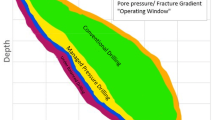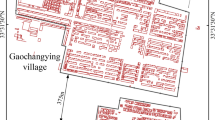Abstract
Aimed to control debris flows more effectively, we attempt to develop a new structure called a “sloping roof grill dam”, which consists of guidance walls, separation grills and lateral deposit areas. A series of flume tests were performed to verify the function of this new structure, focusing on the trapping efficiency (β), deceleration efficiency (μ) and coarse-fine sediment separation extents (η) under different conditions of structure and debris flows. Experimental results show that both the trapping and deceleration efficiency increase with a decrease in permeability, whereas the separation extent shown the opposite effect. Multiple regression analysis indicates that β and η are linearly dependent on the permeability, deceleration efficiency and magnitudes of debris flow. In addition, an increase in beam gap can lead to an increase in the impact area downstream for the debris flow after the control of the structure. Finally, a two-level installation of the structure is tested to determine whether there is an enhancement of the debris control, which indicated that although the trapping effect of the two-level structure is considerably greater than that of a single-level structure (2.11 times at maximum), the separation extent of the two-level structure is not distinct and may be even lower.
Similar content being viewed by others
References
Blair, T. C. (2010). “Sedimentology of the debris-flow-dominated warm spring canyon alluvial fan, death valley.” California. Sedimentology. Vol. 46, No. 5, pp. 941–965, DOI: 10.1046/j.1365-3091.1999.00260.x.
Bowman, E. T., Laue, J., Imre, B., and Springman, S. M. (2010). “Experimental modelling of debris flow behaviour using a geotechnical centrifuge.” Canadian Geotechnical Journal, Vol. 47, No. 7, pp. 742–762, DOI: 10.1139/T09-141.
Brunkal, H. and Santi, P. (2016). “Exploration of design parameters for a dewatering structure for debris flow mitigation.” Engineering Geology, Vol. 208, pp. 81–92, DOI: 10.1016/j.enggeo.2016.04.011.
Cui, Y. F., Zhou, X. J., and Guo, C. X. (2017). “Experimental study on the moving characteristics of fine grains in wide grading unconsolidated soil under heavy rainfall.” Journal of Mountain Science, Vol. 14, No. 3, pp. 417–431, DOI: 10.1007/s11629-016-4303-x.
Costa, J. E. (1984). “Physical geomorphology of debris flows.” Developments and Applications of Geomorphology, pp. 268–317.
Coussot, P. and Meunier, M. (1996). “Recognition, classification and mechanical description of debris flows.” Earth-Science Reviews. Vol. 40, Nos. 3–4, pp. 209–227, DOI: 10.1016/0012-8252(95)00065-8.
Fei, X. J. and Shu, A. P. (2004). Movement mechanism and disaster control for debris flow [in Chinese], Tsinghua University Press.
Guo, C. X., Zhou, J. W., Cui, P., Hao, M. H., and Xu, F. G. (2014). “A theoretical model for the initiation of debris flow in unconsolidated soil under hydrodynamic conditions.” Natural Hazards and Earth System Sciences Discussions, Vol. 2, No. 6, pp. 4487–4524, DOI: 10.5194/nhessd-2-4487-2014.
Han, W. and OU, G. (2006). “Efficiency of slit dam prevention against non-viscous debris flow.” Wuhan University Journal of Natural Sciences, Vol. 11, No. 4, pp. 865–869, DOI: 10.1007/BF02830178.
Hubl, J., Suda, J., Proske, D., and Scheidl, C. (2009). “Debris flow impact estimation.” Proceedings of International Symposium on Water Management and Hydraulic Engineering, Ohrid, Macedonia, pp. 137–148.
Iverson, R. M. (1997). “The physics of debris flows.” Reviews of Geophysics. Vol. 35, No. 3, pp. 245–296, DOI: 10.1029/97RG00426.
Itoh, T., Horiuchi, S., Akanuma, J., Kaitsuka, K., Kuraoka, S., Morita, T., Sugiyama, M., and Mizuyama, T. (2011). “Fundamental hydraulic flume tests focused on sediment control function using a grid-type high dam.” Proceedings of 5th International Conference on Debris-Flow Hazards Mitigation: Mechanics, Prediction and Assessment, ASCE, Padua, Italy, pp. 1051–2061, DOI: 10.4408/IJEGE.2011-03.B-114.
Jaeggi, M. N. R. and Pellandini, S. (1997). “Torrent check dams as a control measure for debris flows.” In: Armanini A, Michiue M (Eds.), Recent Developments on Debris Flows, Springer, Berlin, pp. 186–207, DOI: 10.1007/BFb0117769.
Jakob, D. M. and Hungr, O. (2005). Debris-flow Hazards and Related Phenomena, Springer Berlin Heidelberg.
Johnson, P. A. and Mccuen, R. H. (1989). “Slit dam design for debris flow mitigation.” Journal of Hydraulic Engineering, Vol. 115, No. 9, pp. 1293–1296, DOI: 10.1061/(ASCE)0733-9429(1989)115:9(1293).
Kaitna, R., Palucis, M. M., Hill, K. M., and Dietrich, W. E. (2016). “Effects of coarse grain size distribution and fine particle content on pore fluid pressure and shear behavior in experimental debris flows.” Journal of Geophysical Research Earth Surface, Vol. 121, No. 2, pp. 415–441, DOI: 10.1002/2015JF003725.
Lien, H. P. (2003). “Design of slit dams for control stony debris flows.” International Journal of Sediment Research, Vol. 18, No. 1, pp. 74–87.
Mizuyama, T. (2008). “Structural countermeasures for debris flow disasters.” International Journal of Erosion Control Engineering, Vol. 1, No. 2, pp. 38–43, DOI: 10.13101/ijece.1.38.
Ng, C. W. W., Choi, C., Kwan, J. S. H., Shiu, H. Y. K., Ho, K. S. S., and Koo, R. C. H. (2012). “Flume modelling of debris flow resisting baffles.” Proceedings of the One Day Seminar On Natural Terrain Hazard Mitigation Measures, pp. 17–18.
Okubo, S., Ikeya, H., Ishikawa, Y., and Yamada, T. (1997). “Development of new methods for countermeasures against debris flows.” In: Armanini A, Michiue M. (Eds.), Recent Developments on Debris Flows. Springer, Berlin; Vol. 64, pp. 166–185, DOI: 10.1007/BFb0117768.
Rickenmann, D. (1999). “Empirical relationships for debris flows.” Natural Hazards, Vol. 19, No.1, pp. 47–77, DOI: 10.1023/A:1008064220727.
Shakesby, R. and Matthews, J. (2002). “Sieve deposition by debris flow on a permeable substrate, Leirdalen, Norway.” Earth Surf. Process. Landf, Vol. 27, No. 10, pp. 1031–1041, DOI: 10.1002/esp.390.
Silva, M., Costa, S., and Cardoso, A. H. (2015). “Effect of plan layout on the sediment control efficiency of slit-check dams for stony type debris flows mitigation.” River Basin Management, pp. 259–270. DOI: 10.2495/RM150231.
Tang, C., Asch, T. W. J. V., Chang, M., Chen G. Q., Zhao, X. H., and Huang, X. C. (2012). “Catastrophic debris flows on 13 august 2010 in the Qingping area, southwestern china: the combined effects of a strong earthquake and subsequent rainstorms.” Geomorphology. Vols. 139–140, No. 2, pp. 559–576, DOI: 10.1016/j.geomorph.2011.12.021.
Vandine, D. F. (1996). Debris Flow Control Structures for Forest Engineering, British Columbia Ministry of Forests Research Program, Vancouver, B. C. (available at www.for.gov.bc.ca/hfd/pubs/Docs/Wp/Wp22.htm, 68 p.).
Volkwein, A., Wendeler, C., and Guasti, G. (2011). “Design of flexible debris flow barriers.” Proc., Int. Conf. on Debris-Flow Hazard Mitigation: Mechanics, Prediction, and Assessment, Università La Sapienza, Roma, pp. 1093–1100, DOI: 10.4408/IJEGE.2011-03.B-118.
Wendeler, C., Volkwein, A., McArdell, B. W., Rickenmann, D., Roth, A., and Denk, M. (2006). “Field testing and numerical modeling of flexible debris flow barriers.” In: the 6th International Conference on Physical Modelling in Geotechnics, Hongkong, pp. 1573–1578.
Wendeler, C., Volkwein, A., Roth, A., Herzog, B., Hählen, N., and Wenger, M. (2008). “Hazard prevention using flexible multi-level debris flow barriers.” In Proc. of Int. Symp. Interpraevent, dornbirn, Austria, Band 1, pp. 547–554.
Watanabe, M., Yoshitani, J., and Noro, T. (2008). “Debris-flow dewatering break.”: an efficient tool to control upstream debris-flow to secure road transportation and community safety. Proceedings of the First World Landslide Forum 18–21 November 2008. United Nations University, Tokyo, Japan.
Wendeler, C. and Volkwein, A. (2015). “Laboratory tests for the optimization of mesh size for flexible debris-flow barriers.” Natural Hazards and Earth System Sciences, Vol. 15, No. 12, pp. 2099–2118, DOI: 10.5194/nhess-15-2597-2015.
Xie, T., Yang, H., Wei, F., Gardner, J. S., Dai, Z., and Xie, X. (2014). “A new water–sediment separation structure for debris flow defense and its model test.” Bulletin of Engineering Geology and the Environment. Vol. 73, No. 4, pp. 947–958, DOI: 10.1007/s10064-014-0585-9.
Xie, T., Wei, F., Yang, H., Gardner, J. S, Xie, X., and Dai, Z. (2016). “Calculation of the separation grid design length in a new water–sediment separation structure for debris flow defense.” Bulletin of Engineering Geology and the Environment, Vol. 75, No. 1, pp. 101–108, DOI: 10.1007/s10064-015-0726-9.
Yu, B., Yang, Y. H., Su, Y. C., Huang, W. J., and Wang, G. F. (2010). “Research on the giant debris flow hazards in Zhouqu County, Gansu Province on August 7, 2010 [in Chinese].” Journal of Engineering Geology, Vol. 18, No. 4, pp. 437–444.
You, Y., Chen, X., and Liu, J. (2011). ““8.13” extra large debris flow disaster in Wenjia Gully of Qingping Township, Mianzhu, Sichuan Province.” Journal of Catastrophology, Vol. 26, No. 4, pp. 68–72.
Yong, L. I., Wang, B. L., Zhou, X. J., and Gou, W. C. (2015). “Variation in grain size distribution in debris flow.” Journal of Mountain Science, Vol. 12, No. 3 pp. 682–688, DOI: 10.1007/s11629-014-3351-3.
Zhang, J., Guo, Z. X., Cao, S. Y., and Singh, V. P. (2013). “Scale model for the confluent area of debris flow and main river: A case study of the wenjia gully.” Natural Hazards & Earth System Sciences, Vol. 13, No. 12, pp. 3083–3093, DOI: 10.5194/nhess-13-3083-2013.
Zhou, J. W., Cui, P., Yang, X. G., Su, Z. M., and Guo, X. J. (2016). “Debris flows introduced in landslide deposits under rainfall conditions: The case of Wenjiagou gully.” Journal of Mountain Science, Vol. 10, No. 3, pp. 249–260, DOI: 10.1007/s11629-013-2492-0.
Zhou, J. W., Huang, K. X., Shi, C., Hao, M. H., and Guo, C. (2015). “Discrete element modeling of the mass movement and loose material supplying the gully process of a debris avalanche in the Bayi gully, Southwest China.” Journal of Asian Earth Sciences, Vol. 99, pp. 95–111, DOI: 10.1016/j.jseaes.2014.12.008.
Author information
Authors and Affiliations
Corresponding author
Rights and permissions
About this article
Cite this article
Liang, Yf., Liang, C., Zhou, Hw. et al. New Permeable Structure for Controlling Debris Flows in the Wenjiagou Gully. KSCE J Civ Eng 22, 4293–4305 (2018). https://doi.org/10.1007/s12205-018-1038-y
Received:
Revised:
Accepted:
Published:
Issue Date:
DOI: https://doi.org/10.1007/s12205-018-1038-y




